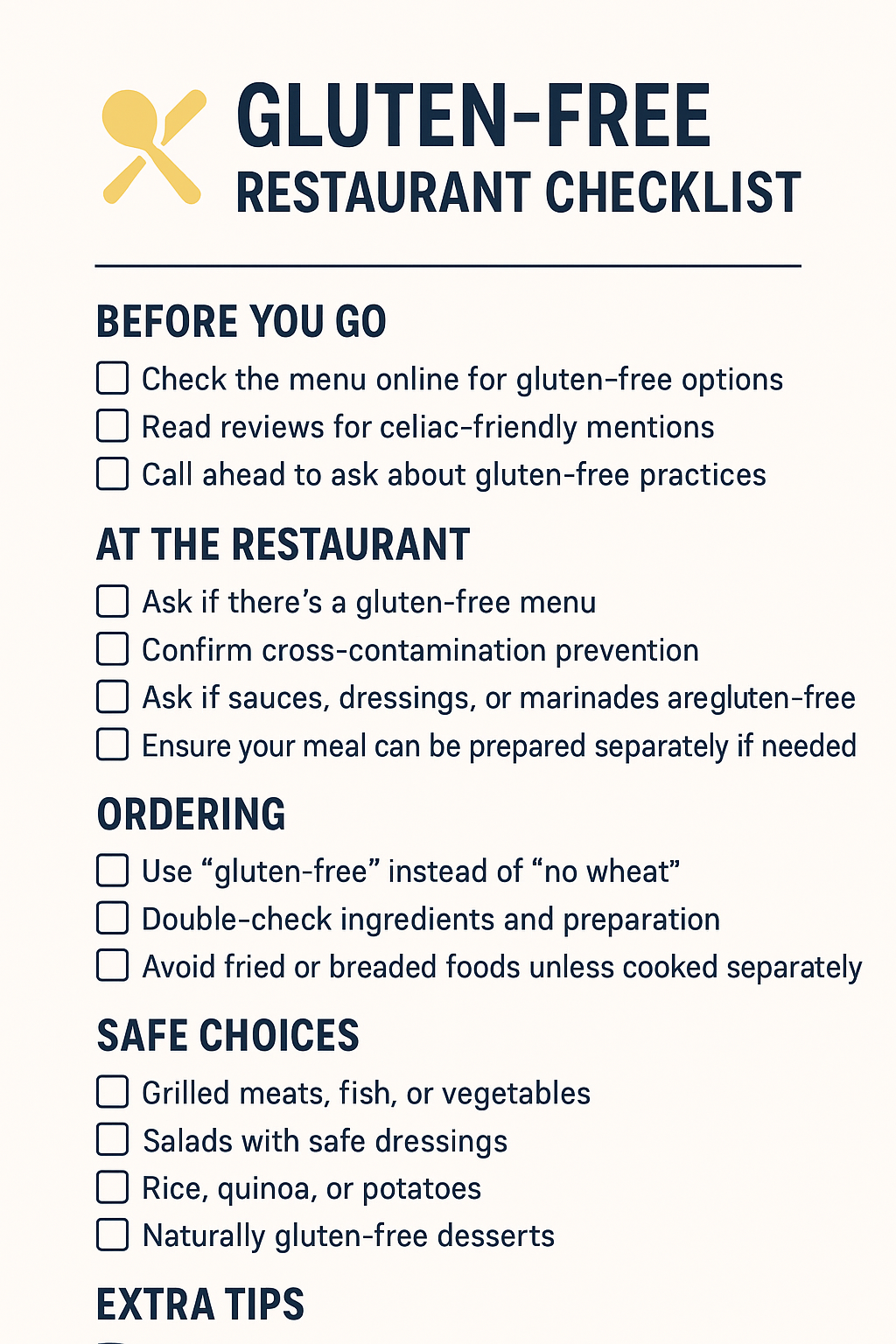Your Essential Checklist for a Safe Dining Experience
Eating out can be stressful when you have celiac disease, but with the right preparation, it can also be a fun and safe experience. Here’s a practical checklist to help you navigate new restaurants confidently and avoid gluten exposure.
For someone with celiac disease, eating at a restaurant carries several risks due to the possibility of gluten exposure:
-
Cross-Contamination – Even small amounts of gluten from shared cutting boards, fryers, utensils, or toasters can trigger symptoms.
-
Hidden Gluten Ingredients – Sauces, soups, marinades, and dressings may contain wheat, barley, or rye derivatives.
-
Menu Miscommunication – Restaurant staff may be unaware of what “gluten-free” truly entails, leading to accidental exposure.
-
Shared Fryers or Grills – Foods labeled gluten-free may still come into contact with gluten-containing foods during cooking.
-
Bulk or Pre-Made Items – Items like bread, pasta, or desserts may contain gluten or be processed in facilities that handle gluten.
Even trace amounts can cause intestinal damage and symptoms in someone with celiac disease, so strict vigilance is necessary.
1. Do Your Homework Before You Go
- Check the menu online: Many restaurants now label gluten-free items or have a separate gluten-free menu.
-
Read reviews: Look for mentions of celiac-friendly options or cross-contamination concerns.
- We love the findmeglutenfree app on the app store.
- Call ahead: Speak to the restaurant manager or chef to ask about their gluten-free procedures.
2. Ask the Right Questions
When you arrive, politely but clearly ask questions such as:
- “Do you have a gluten-free menu?”
- “How do you prevent cross-contamination in the kitchen?”
- “Can my meal be prepared separately or with dedicated utensils?”
- “Are any sauces, dressings, or condiments gluten-free?”
- Sauces are hidden danger points. Most restaurants will just hold the sauce but be careful as some servers will not know.
3. Be Wary of Hidden Gluten
Even if a menu item seems safe, watch out for:
- Breaded or fried foods (cross-contamination in oil is common)
- Ask if they have a dedicated fryer.
- Soups, sauces, and gravies thickened with wheat flour.
- Double check, Triple Check, any sauce or gravy.
- Marinades, soy sauce, or spice mixes that may contain gluten
- Tamari soy sauce! If they have it, then they know.
- Pre-made dressings or condiments.
- If they don't know then don't eat it.
4. Communicate Clearly with Your Server
- Use the words “gluten-free” or “celiac-safe” rather than “no wheat,” which can sometimes be misinterpreted.
- Ask the server to write down your allergy or ensure the kitchen staff is aware. Ask how they communicate it to the kitchen.
- Be patient but firm—sometimes servers need reminders. It is your health, and you are their customer.
5. Consider Safe Meal Options
Some generally safer choices include:
- Grilled meats, fish, or vegetables (without marinades containing gluten)
- Salads with plain dressings or olive oil and vinegar
- Rice, quinoa, or potato sides
- Be careful with mashed potatoes as they could be cross contaminated or have thickeners that are not gluten free.
- Naturally gluten-free desserts, like flourless chocolate cake just check cross contamination.
6. Watch Out for Cross-Contamination
Even “gluten-free” items can be risky if handled incorrectly. Ask:
- Are separate cutting boards, utensils, or fryers used?
- Are gluten-free items stored away from gluten-containing foods?
7. Trust Your Instincts
If something feels off, it’s okay to skip an item or order something safer. Your health comes first.
8. Have a Backup Plan
- Bring a small gluten-free snack, just in case.
- Keep a list of trusted restaurants that are familiar with celiac needs.
- When in doubt ask for a piece of fruit un-altered.
9. Follow Up
If you do experience symptoms after eating out, make a note of the restaurant and meal. This can help you avoid risky items in the future and may help the restaurant improve its gluten-free practices.
Final Tip: Eating out with celiac disease is about preparation, clear communication, and trusting your instincts. With this checklist in hand, you can enjoy dining experiences while staying safe and symptom-free.
Here is a free checklist to take to the restaurant to help keep everyone safe:
🍴 Gluten-Free Restaurant Checklist
Before You Go:
-
Check the menu online for gluten-free options
-
Read reviews for celiac-friendly mentions
-
Call ahead to ask about gluten-free practices
At the Restaurant:
-
Ask if there’s a gluten-free menu
-
Confirm cross-contamination prevention
-
Ask if sauces, dressings, or marinades are gluten-free
-
Ensure your meal can be prepared separately if needed
Ordering:
-
Use “gluten-free” instead of “no wheat”
-
Double-check ingredients and preparation
-
Avoid fried or breaded foods unless cooked separately
Safe Choices:
-
Grilled meats, fish, or vegetables
-
Salads with safe dressings
-
Rice, quinoa, or potatoes
-
Naturally gluten-free desserts
Extra Tips:
-
Bring a small gluten-free snack just in case
-
Keep a list of trusted restaurants
-
Note any symptoms after eating to avoid risky items in the future
